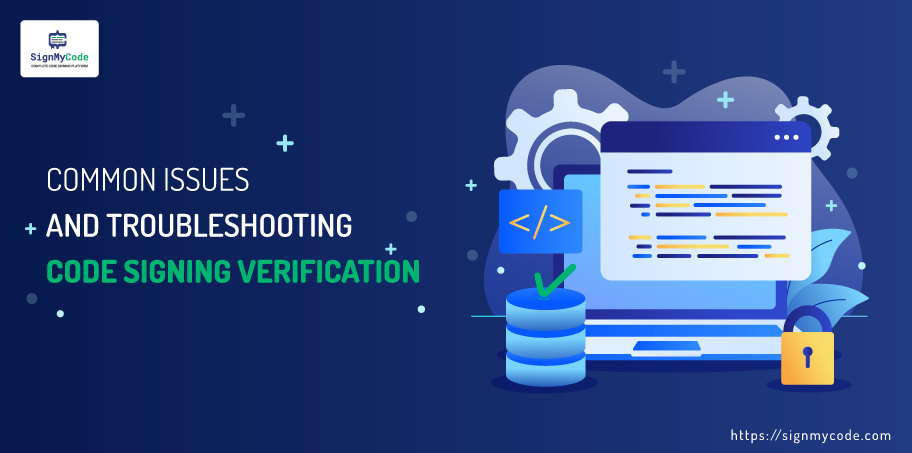Troubleshoot Code Signing Verification Issues: Tips and Tricks

Introduction
In the sphere of digital technology, code signing is recognized to be one of the most essential security measures for both software developers and entities. It allows checking if the software was developed and assembled only by the team.
It is confirmed that whoever does not have bad intentions has not damaged or changed it. On the other hand, while code sign verification’s catalytic role cannot be overstated, it is not exempted from setbacks that are not quite easy to deal with.
This article intends to serve as a complete source of information and provide solutions to frequently encountered problems related to code signing verification.
Common Issues in Code Signing Verification
Expired or Revoked Certificates:
Verifying code signing codes is one of the most tedious challenges during code signing verification. The problem can be the use of expired or revoked certificates. These certificates are not valid for a long time. Therefore, if their renewal or replacement is not done promptly, the code signing process may fail.
Incorrect Certificate Chain:
Certificate of code, signed as a rule and forms a chain of certificates, including the root CA and intermediate ones issued for them. If, in the certificate chain, the server conf or installation does not correspond with the target system, errors may be encountered during the code signing verification.
Timestamp Issues:
Building in timestamping is an inseparable part of code signing, for it gives the possibility to confirm that the code is still valid and corresponds to a given timestamp. If the timestamp server is inaccessible or if there are problems with the timestamp signature, then code signing verification might ensue.
Missing or Incorrect Root Certificates:
The CA, which is the indigenization that issues a code signing certificate, must be trusted by the target system and oriented toward the code signing. If the key to the root CA certificate is absent or improperly installed, verification fails.
Software Compatibility Issues:
Code signing verification often uncovers compatibility problems between the software to be signed and the system, which can present some demerits. These problems may be caused by varying operating systems, software versions, or versions of adjacent components.
Hardware or Driver Compatibility:
In some cases, the signing verification issues can manifest in the interplay between the drivers or computer hardware. This happens if the software being authenticated communicates with specific hardware components or drivers that are either not properly configured and supported or do not interact correctly with those components or drivers.
Troubleshooting Code Signing Verification
Verify Certificate Validity:
The foremost step in resolving code signing verification problems entails validating the certificate to a valid one that has not been revoked.
You can verify the certificate authority who issued it using many different tools and utilities provided by certification authorities or the operating system. Besides updating the certificates and date of validity, do program the renewal or replacement before or soon after they expire.
Check Certificate Chain:
If the certificate path is invalid or lacks depth, the signing path will fail to verify the code. Online tools or CA utilities can validate the input certificate and establish that the target systems’ intermediate and root CA certificates are correctly installed and trusted.
Troubleshoot Timestamp Issues:
Timestamp-related problems can be solved using a timestamp server update procedure. Alternatively, you can still go for a different timestamp server. To sum up, you can verify that the system time is correct and adjust it accurately with a time source using NTP tools.
Install or Update Root Certificates:
If the root CA certificate is missing or not done, you may either download or install the latest root certificate from the CA’s case.
Verify that the certificate or key is put or set up in the correct folder and escorted by the operating system. It should always be checked for updates, and new root certificates should be installed as soon as they are available.
Update Software and Drivers:
If your software is signed and you experience issues like compatibility, consider updating to the latest versions of your software and drivers or contacting a technical support service.
The main goal of software updates is to fix problems with the code, and they also include solutions to known incompatibility problems and security vulnerabilities. Similarly, check the drivers for your hardware to get the latest update. That will smooth the signing process.
Check Hardware and Driver Configurations:
If you encounter an incompatible driver or hardware issue, you should try updating the drivers or reconfiguring the hardware setting.
If necessary, consult the manufacturer’s documentation or support from the hardware vendor. Validating the signed software and hardware integrities during the configuration process can confirm these code signing problem uncertainties.
Review Permissions and Access Rights:
To ensure that only authorized users and processes can verify the code signing, correctly set permissions, and access rights to resources, including certificates and system files.
Review and adjust the permissions if necessary or perform a verification once the privilege is elevated if such a case occurs.
Configure Antivirus and Security Software:
If the antivirus or security software is human antivirus or security software as the culprit for these conflicts or false positives during code signing verification, ensure it is appropriately configured.
To avoid disputes, giving trust only to trusted apps, setting exceptions, and intermittently disabling them when code signing verification is in progress are measures that will work.
Enable Verbose Logging:
Most code signing software and tools can log more details, which are verified during the evaluation process. If you need to do it, enabling verbosity logging will help you find the source of the issue and get useful information for the problem-solving process.
Seek Professional Assistance:
If you encounter all the possible difficulties and still cannot scan the problem, try requesting expert assistance from the certification authority, the software vendor, or a qualified professional specializing in computer code signing and security. Expert help can offer customized remedies and advisory one-on-one settings.
Conclusion
Avoid giving the code signing verification matters an edge by introducing security jeopardy and integrity risks to your software. Stand and act immediately while using these measures.
Make it a routine to verify and revise your code signing workflow regularly to comply with different security standards and risk management methods.


